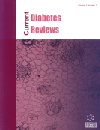-
oa Comparative Effectiveness of Oral Hypoglycemic Agents for Glycemic Control and Glycemic Variability in Patients with Type 2 Diabetes Mellitus: Using Flash Glucose Monitoring
- Source: Current Diabetes Reviews, Volume 21, Issue 1, Jan 2025, E160124225706
-
- 15 Aug 2023
- 16 Nov 2023
- 16 Jan 2024
Abstract
The study aimed to compare the effectiveness of oral hypoglycemic agents (OHAs) as monotherapy, dual and quadruple therapy for glycemic control (GC) and glycemic variability (GV) in patients with type 2 diabetes (T2DM) using flash glucose monitoring system (FGM).
Diabetes management largely relies on HbA1c monitoring. Glycemic variability has been an evolving glycemic target for preventing complications related to type 2 diabetes mellitus.
The purpose of the study was to compare glycemic control measures and glycemic variability measures among study groups and to study the relationships between GC and GV indices.
Retrospectively, FGM data were collected from 50 T2DM patients. The patients were classified based on prescribed number of OHAs as monotherapy [group 1: Dipeptidyl peptidase- 4 (DPP-4) inhibitors (n=10), group 2: Sodium-glucose co-transporter-2 (SGLT2) inhibitors (n=10), group 3: Sulphonylureas (n=10), group 4: Dual therapy (n=10), and group 5: Quadruple therapy (n=10)]. Measures of GC and GV were evaluated.
Significant differences between study groups were observed in GC and GV measurements. The SGLT2 inhibitors monotherapy group demonstrated optimal GC [eA1c (%): 6.5 ± 2.2; MBG: 140.80 ± 63.94; TIR: 60.60 ± 19.96] and GV (SD: 42.38 ± 34.57; CV: 27.85 ± 6.68; MAGE: 96.76 ± 52.47; MODD: 33.96 ± 22.91) in comparison to other study groups. On using Pearson correlation analysis, mean blood glucose (MBG) and mean amplitude of glycemic excursion (MAGE) showed moderate correlation (r = 0.742)(r2 = 0.551), depicting distinct glucose variabilities at the same mean blood glucose levels.
The monotherapy group of SGLT2 inhibitors demonstrated glucose-lowering effects with reduced glycemic variability. Hence, optimum glycemic control is associated with decreased glycemic variability.


